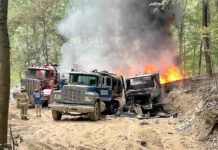SALEM, Ohio — There is nothing that can prepare Ohio for carbon capture and sequestration, according to opponents of Ohio House Bill 170.
The bill, introduced by state Sen. Monica Robb Blasdel, R-Columbiana, would establish a framework for carbon capture and sequestration, also known as Class VI injection wells, in Ohio, and grant regulatory authority to the Ohio Department of Natural Resources.
This is the first step in getting primacy, or regulatory power, over Class VI wells from the federal government. There are only four other states that have Class VI primacy: North Dakota, Louisiana, Wyoming and West Virginia. West Virginia most recently received primacy in January.
House Bill 170 had its third hearing in the Ohio House of Representatives Natural Resources Committee on May 7, where legislators heard opposition testimony on the bill. Previous hearings included proponent testimony from oil and gas companies and farm/biofuels groups, as well as sponsors of the bill.
While proponents of the bill see CCS technology as the next economic opportunity and a climate solution for Ohio, environmental advocates say it is just another false promise.
“I don’t think there’s anyway this can be safe,” said Randi Pokladnik, a chemical and environmental engineer and resident of Harrison County, Ohio. “The bill is just a fluff piece in my opinion as a scientist.”
First hearings
Carbon capture and sequestration is the process of capturing carbon dioxide and storing it in the ground via Class VI wells to reduce emissions from power plants, coal plants, fracking operations and other heavily polluting industries. The U.S. Environmental Protection Agency permits and regulates Class VI wells in states without primacy.
Under the introduced language of the bill, the Ohio Department of Natural Resources Division of Oil and Gas Management would be responsible for regulating Class VI injection wells. ODNR already regulates Class II injection wells, which are used to dispose of oil and natural gas wastewater and related fluids.
According to the legislation, carbon would be injected into “pore space,” defined as subsurface cavities and voids that are suitable for sequestration space for carbon.
The bill creates language recognizing pore space as a landowner’s property, meaning that whoever owns the surface rights and water of a property also owns the pore space. Landowners have the right to this pore space unless they choose to sell off their rights.
CCS operators would have to get consent from at least 70% of landowners in order to establish a CCS well — a process known as forced pooling. Similarly, Pennsylvania and West Virginia have enacted forced pooling in their CCS legislation. ODNR could also require CCS operators to conduct seismic monitoring to determine seismic activity.
According to Blasdel, the current federal permitting process is long, and companies have faced year-long delays when trying to implement CCS technology.
“The federal regulation and permitting is out of touch with the needs of our state and serve as a barrier to ensuring Ohioans’ perspectives influence this process,” Blasdel said, during the bill’s first hearing on April 9.
Co-sponsor of the bill state Sen. Bob Peterson, R-Sabina, adds that if Ohio doesn’t enact legislation to get primacy for Class VI wells like neighboring West Virginia, the state will lose out on economic opportunities and jobs. There are currently five Class VI well applications in Ohio under review with the U.S. EPA.
During the second hearing on April 30, energy companies and trade organizations, representing oil and gas and biofuel interests, provided proponent testimony, including representatives from American Petroleum Institute Ohio, Tenaska, Battelle and Advanced Resources International, a consulting, research and development firm that provides services related to unconventional oil and gas development.
According to Andrew Duguid, vice president of Advanced Resources International, average CCS projects will last between 12 and 30 years. Safety practices will also be similar to oil and gas wells, including putting cement from top to bottom outside of the well casing to ensure carbon dioxide does not escape.
Others like Neeraj Gupta, senior research leader at Battelle, say that although there are only a few CCS projects currently in the country, CCS for enhanced oil recovery has been happening for decades. Enhanced oil recovery is the process of capturing and injecting carbon dioxide into oil reservoirs to increase production and store carbon dioxide underground.
According to EPA data, there are two active Class VI wells in the injection phase in the country.
Third hearing
While industry leaders say CCS technology is ready to go, environmental activists and opponents of the bill say CCS technology is underdeveloped and communities are not prepared for carbon injections.
“Even though people have been doing carbon injection, they have not been doing it in Ohio. There was one experimental well drilled in 2011 in Gnadenhutten,” Pokladnick said. “They have no experience with our bedrock.
Pokladnick and others say the plethora of unconventional oil and gas wells, injection wells and orphan wells in the state make it an unsuitable place for CCS wells, as these wells could allow easy pathways for CO2 to escape.
She adds that when CO2 meets groundwater via aquifers, the water could become acidic. According to a study published in Environmental Science & Technology in 2011, this combination can leach heavy metals into the water.
CO2 can also corrode the cement used to seal off orphan wells, causing another pathway for CO2 to escape, Pokladnik said.
First responders are not trained to deal with CO2 poisoning, adds Pokladnick. She points to a CO2 poisoning incident that took place in Satartia, Mississippi, in February 2020 where a pipeline transporting carbon dioxide to an oil well exploded.
According to federal regulators, the pipeline ruptured after weeks and months of rain that caused the uneven ground to shift. The extreme levels of carbon dioxide left several residents unconscious and others with lasting respiratory and cognitive problems. The lingering CO2 cloud also hampered first responders’ ability to help as the carbon monoxide displaced oxygen in the air, preventing combustion engines in vehicles from running.
Interested parties were also concerned about ODNR’s ability to regulate CCS wells, as leakage accidents at Class II wells have increased over the years.
Bob Wilson, owner of Wilson Energy LLC, in Marietta, Ohio, said the ODNR is understaffed and cannot handle inspections at Class II wells currently, let alone Class VI wells.
Wilson and Robert E. Lane, president of Bethel Oil and Gas, also of Marietta, told the committee that they had conventional oil and gas wells that were shut down due to the migration of wastewater from Class II injection wells in Washington County. Lane had four of his 65 wells shut down by ODNR and Wilson had 45 oil and gas wells “ruined.”
“The water is always showing up on the surface; the carbon is going to do the same thing,” Wilson said at the May 7 hearing.
Landowners and taxpayers
Environmental activists were also concerned about the forced pooling language included in the legislation.
Pokladnik, whose property was forced pooled into an oil and gas unit in January 2024, says they did not want to be part of the unit, but that they could not fight it. “It’s not fun and it’s not dignified to tell private landowners that we can’t control our land,” Pokladnik said at the hearing.
Evan Callicoat, director of state policy for Ohio Farm Bureau Federation, echoed concerns about forced pooling at the hearing and asked the committee to consider increasing the percentage to 75% of consent of landowners.
The farm bureau recommended other small changes to the bill, but supports it overall, as CCS could increase ethanol and biofuel production in Ohio, creating more market demand for Ohio crops, according to Callicoat.
House Bill 170 also severs CCS well operators from liability 50 years after carbon injection ceases via a certificate of project completion; this is similar to Class II well owners regarding fracking waste currently.
The bill, however, also establishes a carbon dioxide storage facility fund, which is paid by storage operators to ODNR, to be used for post-closure care of CCS wells.
To get a certificate of project completion, operators have to prove to ODNR that the project is over, according to Duguid, vice president of Advanced Resources International. ODNR would then issue the certificate to the well owner and the liability for the well would pass on to the state.
“There’s so many issues with that and the biggest one is you are taking private property and you’re using it for an industry that doesn’t care about our area, doesn’t care about our citizens. They care about one thing: money and perpetuating fossil fuel development.”
As of May 27, the bill had yet to be voted on by the full House Natural Resources Committee.
(Liz Partsch can be reached at epartsch@farmanddairy.com or 330-337-3419.)










